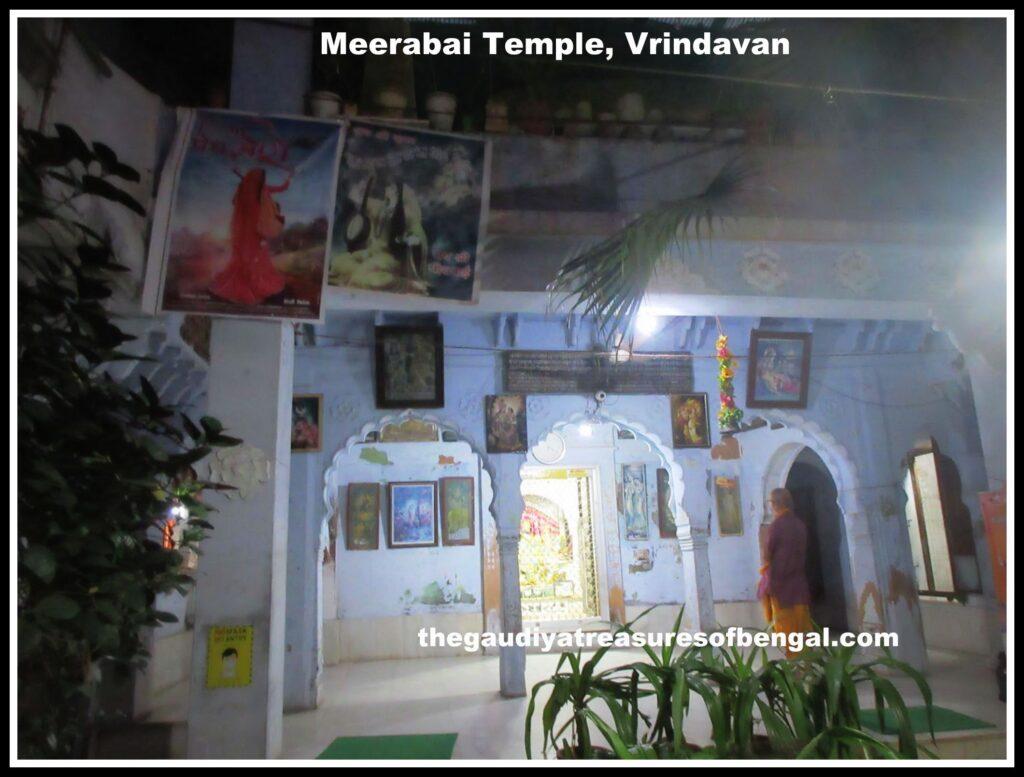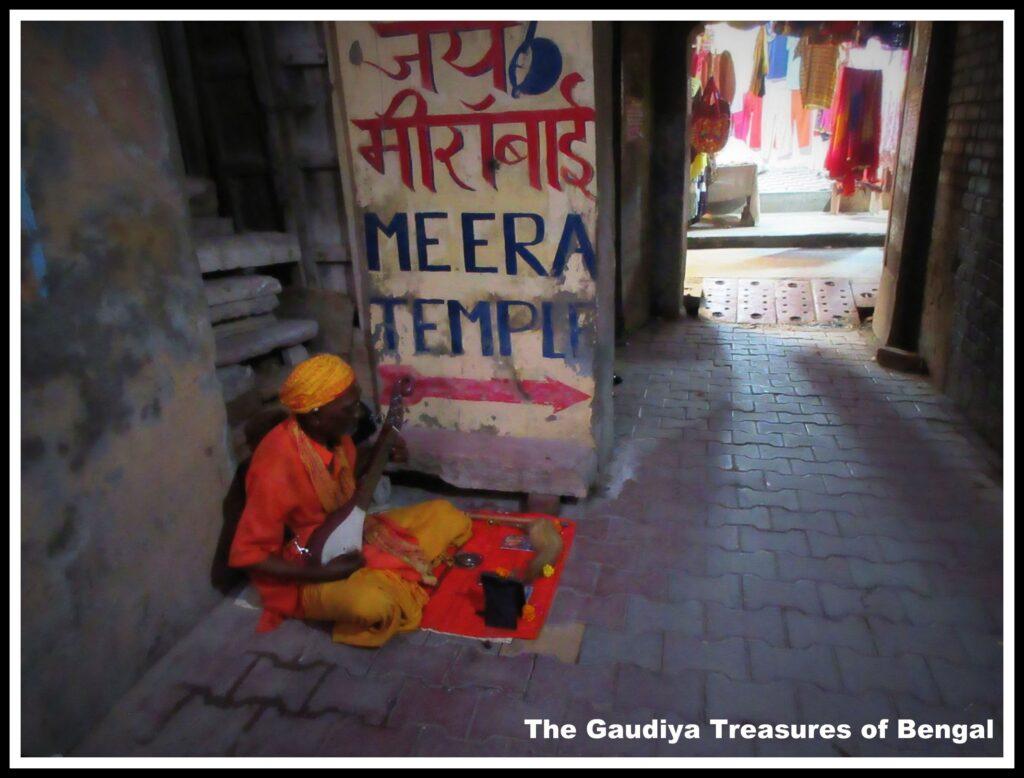
The enchanting Meerabai Temple can be found tucked away on a tranquil street adjacent to Shah Ji Temple in Vrindavan. A short distance away lies the mystical Nidhivan, adding to the spiritual ambiance of the area. As the legend goes, after abandoning the luxurious life of Chittorgarh, Meerabai found solace in Vrindavan. It was during this time that she fervently worshiped Krishna in the form of a shaligram sila, which is still venerated today within the walls of the temple. The sacred grounds of Meerabai Temple are diligently looked after by the descendants of the very family that welcomed Meerabai with open arms in the 15th century. The temple exudes a powerful aura of devotion and piety, beckoning visitors to bask in the divinity and history of the revered saint.
History of Meerabai Temple
Legend has it that the renowned saint, Meerabai, sought refuge in Vrindavan in 1524, in her unwavering quest to seek Lord Krishna. It was in this quaint town that she resided for fifteen years, until 1539, before making her way to Dwarka, where she is said to have merged into the deity of Lord Krishna at the revered RanChod Temple.
From a tender age, Meerabai was a devout follower of Lord Krishna. She is said to have considered herself as Krishna’s wife after her mother playfully referred to him as such. Born in the village of Kurki, in Marwar, Jodhpur, Meerabai’s mother passed away early in her life, and she was married to the crown prince of Chittor, Prince Bhojraj, son of Maharaja Sangram Singh. Despite her marital duties, Meerabai remained steadfast in her worship towards Lord Krishna, writing and singing songs for him.

However, her devotion was not accepted by the royal family, and they repeatedly tried to curb her ardor towards the deity. After her husband’s untimely death in battle, his brother, Rana Bikramjit Singh, ascended to the throne and attempted to thwart Meerabai’s worship. He even went as far as trying to poison her, but Meerabai miraculously found a shaligram sila instead in the box that contained poison. This shaligram sila is now enshrined within the hallowed confines of the Meerabai Temple in Vrindavan.
Despite the familial pressures, Meerabai refused to give up her devotion towards Lord Krishna and ultimately decided to leave Chittor. It was in Vrindavan, at the very place she resided in, where she found solace and continued to sing praises of Lord Krishna until she left for Dwarka. The Meerabai Temple was constructed by Thakur Ram Narain Bhatti of Bikaner in 1842, according to the Hindu calendar, Vikram Samvat 1898, and has been meticulously taken care of by the descendants of the same family, who once hosted her over five centuries ago.
Compositions of Meerabai
Meerabai was a prominent saint, poetess, and devotee of Lord Krishna, whose writings have stood the test of time and continue to inspire generations. Her poems, or bhajans, are deeply spiritual, and their themes revolve around the intense love and devotion that she had for Lord Krishna. Meerabai’s compositions were unique for their simplicity and accessibility, and they could be understood and appreciated by people from all walks of life.
Meerabai’s bhajans have been widely translated into various languages and are still sung and recited in temples and homes across India. Her writings are characterized by a deep sense of devotion, longing, and surrender to Lord Krishna. Through her bhajans, Meerabai expressed her unbridled love for her beloved Lord, and her writings are considered to be some of the most powerful expressions of Bhakti, or devotional love, in the Hindu tradition.

Here are a few examples of Meera Bai’s writings:
- “Payoji Maine Ram Ratan Dhan Payo” – This is one of Meera Bai’s most famous bhajans. It expresses her devotion to Lord Rama and her gratitude for the blessings she has received.
- “Mere To Giridhar Gopal” – In this bhajan, Meera Bai expresses her love for Lord Krishna, whom she considers to be the ultimate source of happiness and fulfillment.
- “Hari Tum Haro Jan Ki Peer” – This bhajan is a plea to Lord Hari (Vishnu) to relieve the suffering of all living beings and to grant them salvation.
- “Manmohan Kanha Vinti Karu” – This bhajan is an appeal to Lord Krishna to come and dwell in the devotee’s heart and to grant them the strength to overcome all obstacles in their path.
- “Giridhara Gopala” – In this bhajan, Meera Bai describes the beauty and grace of Lord Krishna and expresses her desire to be in his divine presence always.
These are just a few examples of Meera Bai’s vast collection of bhajans, which are still beloved and widely sung in India today.
How to Reach Meerabai Temple
To reach Meerabai Temple in Vrindavan, you can follow these directions:
- By Air: The nearest airport to Vrindavan is the Indira Gandhi International Airport in New Delhi, which is about 150 kilometers away. From there, you can hire a taxi or take a bus to Vrindavan.
- By Train: Vrindavan has its own railway station, which is well connected to major cities in India. You can take a train from Delhi, Agra, Jaipur, or Mathura to reach Vrindavan.
- By Road: Vrindavan is well connected by road to major cities in the region. You can take a bus or hire a taxi from Delhi, Agra, or Mathura to reach Vrindavan.
Once you reach Vrindavan, you can make your way to Nidhivan, which is a well-known location in the city. From there, you can ask any local resident or shopkeeper for directions to Meerabai Temple. The temple is located near a narrow street adjacent to Shah Ji Temple, and it is just a short walk from Nidhivan.